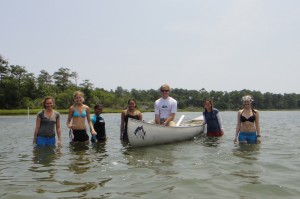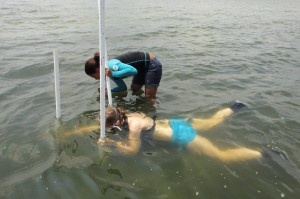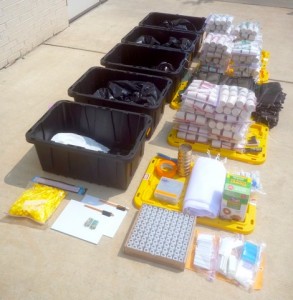A swim down memory lane
by Pamela Reynolds (ZEN coordinator)
The past several months we’ve been entrenched in finishing processing the experimental samples, analyzing data and writing up the results. This is a big switch from our constantly on the go routine during field season, and gives us time to reflect on what an amazing past two years we’ve had with ZEN. In that vein, I’ve dug up two pre-blog posts, quick little snippets I wrote back in the summer of 2011 before we launched the ZENscience.org website.
August 2011: Fieldwork Happens
Out in the field, the one thing I dread most isn’t encountering sharks in the murky water, seeing lightning streak overhead, or being pursued by voracious horseflies. Nope – it’s Murphy’s Law. We’ve all experienced it. A perfectly planned experimental setup can go from a well rehearsed orchestra to utter cacophony in a split second simply because someone forgot to bring scissors or dropped the ruler overboard, or a rogue wave made off with a pencil.
In our case, after placing and pounding 320 poles in the water we realized that our once lovely Zostera bed is now overgrown with Ruppia, a different type of seagrass. In our defense, the seagrass in the clearer water near the approach to the site was, in fact, Zostera. Murphy rears his ugly head, once again. How to deal with the mishap? Remove the poles, all 320 of them, call a few colleagues to find a new site, borrow a boat, and start over. This time everyone knew the drill and the setup went exceedingly smoothly. And, in the process we all learned how to distinguish the three local types of seagrass (Zostera, Ruppia, Halodule) by touch alone in the murky water. Turning Murphy into an educational experience – now that’s science! Having a team of graduate and undergraduate students who keep smiling? Priceless.
[Update: While I still despise coming up short on cable ties in the field, getting caught out on the water during a thunderstorm has quickly risen to fear #1. See the "Science is electric" blog post from 2012 to find out why.]
April 2011: When it absolutely, positively has to be there overnight
In preparing for ZEN the VIMS team became well versed in navigating international shipping. One of the things we learned early on was that customs agents are often quite literal. For instance, “300 blocks of 120 mL hardened dental plaster” can be translated into medical equipment and is subject to high tariffs. Doesn’t matter that the plaster has already been hardened and can’t be used to make casts of someone’s teeth – it’s all in the product description. And being vague isn’t much help either. Some countries want to know the composite materials of a t-shirt or line items of every ingredient in the dog food we used as fish bait, while for others the phrase “for education/research, not for resale” is sufficient. We are expecting that to some extent each country will have unique mesograzer assemblages and ecological interactions – why should we assume their import/export process to be the same?
[Update: I wrote this after a week of playing phone tag and emailing with shipping and customs agents to get our packages cleared and on their way to our international partners. Ultimately everything went through and there were no major delays or disruption of our partners' field schedules. Lesson learned? Leave at least a 3 week shipping allowance for international projects. And, keep UPS on speed dial!]





Comments are closed.